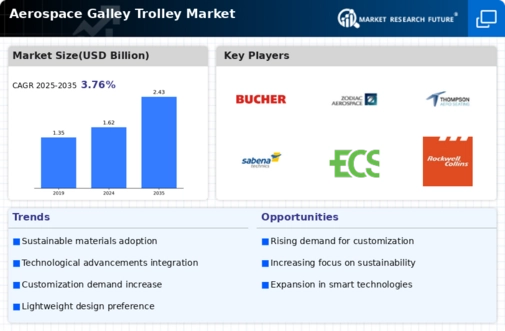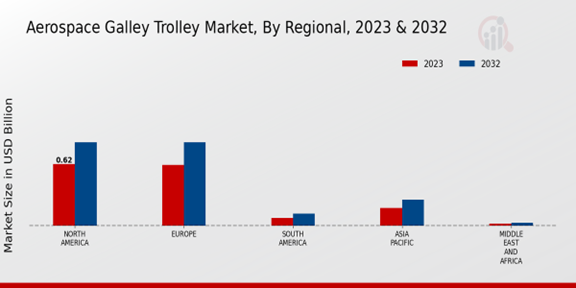Market Growth Projections
The Global Aerospace Galley Trolley Market Industry is projected to experience steady growth, with a compound annual growth rate (CAGR) of 3.75% from 2025 to 2035. This growth trajectory suggests a sustained demand for galley trolleys as airlines continue to expand their fleets and enhance in-flight services. The market is expected to reach 1.62 USD Billion in 2024 and further grow to 2.43 USD Billion by 2035. These projections indicate a positive outlook for manufacturers and suppliers within the industry, as they prepare to meet the evolving needs of airlines and their passengers.
Increasing Air Travel Demand
The Global Aerospace Galley Trolley Market Industry is poised for growth due to the rising demand for air travel. As more individuals opt for air transportation, airlines are compelled to enhance their in-flight services, which includes upgrading galley equipment. The market is projected to reach 1.62 USD Billion in 2024, reflecting a significant investment in passenger comfort and service efficiency. Airlines are increasingly focusing on providing a better travel experience, which drives the need for modern galley trolleys that can accommodate diverse meal options and beverages. This trend indicates a robust future for the industry as air travel continues to expand globally.
Growing Competition Among Airlines
The competitive landscape of the Global Aerospace Galley Trolley Market Industry is intensifying as airlines strive to differentiate themselves. To attract and retain customers, airlines are investing in enhanced in-flight services, which includes upgrading their galley trolleys. This competition drives innovation and improvements in trolley design, functionality, and efficiency. Airlines are likely to seek trolleys that not only meet operational needs but also enhance the overall passenger experience. As the market evolves, the focus on unique service offerings may lead to increased demand for specialized galley trolleys tailored to specific airline requirements.
Regulatory Compliance and Safety Standards
The Global Aerospace Galley Trolley Market Industry is influenced by stringent regulatory compliance and safety standards imposed by aviation authorities. Airlines must adhere to these regulations to ensure passenger safety and operational efficiency. Compliance with safety standards necessitates the use of high-quality materials and designs that can withstand the rigors of air travel. This requirement drives demand for advanced galley trolleys that meet or exceed these regulations. As safety becomes a paramount concern for airlines, investments in compliant galley equipment are likely to increase, further propelling the market's growth.
Technological Advancements in Trolley Design
Innovations in materials and design are transforming the Global Aerospace Galley Trolley Market Industry. Manufacturers are increasingly utilizing lightweight materials such as aluminum and composite materials, which enhance fuel efficiency and reduce operational costs for airlines. Advanced designs allow for better storage solutions and ease of use for cabin crew, thereby improving service delivery. The integration of smart technology, such as temperature control and tracking systems, is also gaining traction. These advancements not only improve the functionality of galley trolleys but also align with the industry's sustainability goals, making them more appealing to airlines looking to modernize their fleets.
Focus on Sustainability and Eco-Friendly Solutions
Sustainability is becoming a critical driver in the Global Aerospace Galley Trolley Market Industry. Airlines are increasingly adopting eco-friendly practices, which include the use of recyclable materials in galley trolley production. This shift is not only a response to consumer demand for greener options but also aligns with global initiatives to reduce carbon footprints. The market is expected to grow to 2.43 USD Billion by 2035, as airlines invest in sustainable solutions that enhance their corporate responsibility image. The emphasis on sustainability may lead to innovations in trolley design and materials, further influencing market dynamics.















